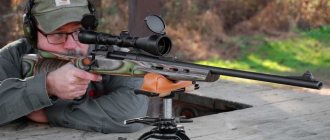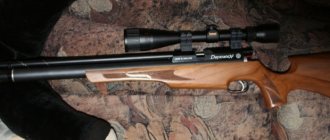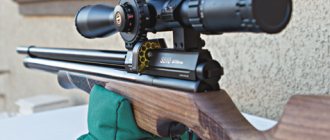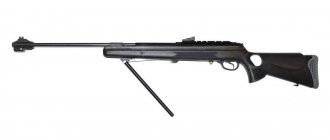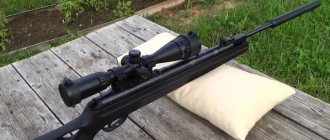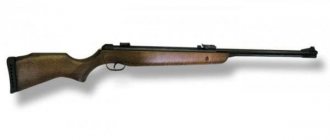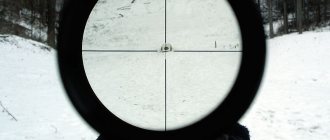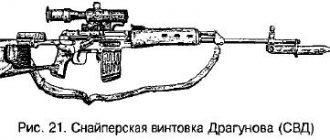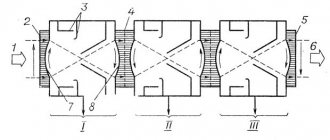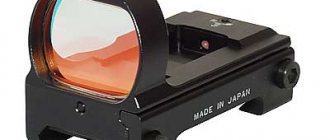- March 15, 2019
- Weapons and ammunition
- Natali Michaelis
Zeroing an air rifle is just as important as it is with a firearm. A well-tuned open sight significantly increases the combat range, and also allows you to use the rifle not only as efficiently as possible, but also safely. However, not all owners are well versed in the principles of setting up sighting devices, which is why the weapon malfunctions at long distances. We’ll talk about how to properly zero an air rifle in our article.
Depreservation
The process of re-opening a weapon is mandatory if you are planning to set up an open sight on a newly purchased rifle. However, this procedure should also be carried out for firearms.
What is the deconservation process? The fact is that most weapon manufacturers use a large amount of lubricant, which negatively affects the accuracy rate, so you should get rid of it.
A schematic depreservation algorithm should look something like this:
- disassemble the rifle;
- we remove the shock-spring mechanism from it;
- we get rid of preservative factory lubricant;
- We clean all elements of the compressor system.
During the cleaning procedure, it is worth using special compounds and solvents, which can be purchased in specialized stores. After this, all that remains is to treat all mechanisms with silicone grease.
Position selection
Zeroing an air rifle is best done indoors, where the flight of a ballistic projectile will not be influenced by natural factors (wind, air humidity, precipitation). However, going to a shooting range may seem like an unaffordable luxury for some owners, so you will have to choose a shooting spot in an open field. In this case, the position for setting up an open sight on a pneumatic rifle must meet the requirements listed below.
- A fairly large open space that will allow you to gradually increase the distance from the shooter to the target. It should also be free of foreign objects, dense vegetation and anything else that could interfere with aiming.
- Flat terrain for easy shooting. Proper zeroing always involves using a horizontal surface for support, and if the terrain is bumpy, the fixing machine or bipod will constantly wobble.
- Safety for bystanders and the shooter himself. It is recommended to find a deserted place where no one will disturb you. Remember that the sound of a gunshot can be heard from a great distance, so look for a field away from a populated area.
As already mentioned in the second paragraph, it is recommended to use a special machine or bipod to secure the weapon. An alternative is a sandbag or any other horizontal surface on which it will be convenient to place the forend.
Preparing to zero the aircraft
Shooting an air gun without optics has its own characteristic features. It does not need to be fixed in the machine, and the firing range should not exceed 50 meters. Usually shooting occurs from a rest or from the hand. To shoot a pneumatic gun correctly, you must follow the principles of setting and adhere to the recommendations of specialists.
Depreservation
Setting up your sights correctly on an airborne rifle without a telescopic sight is just as important as it is on a firearm. But before zeroing the weapon, it must be cleaned of magazine grease, which reduces shooting accuracy.
To do this, the following algorithm of actions is observed:
- There is a complete disassembly of pneumatic weapons;
- the shock-spring mechanism is released;
- All conservation lubricant is removed and the mechanism of the compressor system is cleaned.
For cleaning, compounds and solvents are used that can only be purchased in specialized stores. After removing the factory grease, all mechanisms should be treated with a silicone compound.
Target selection
To shoot an aerial target without optics and correctly adjust your shooting, it is best to use targets with black and white markings (as in biathlon). For this, standard A4 sheets are used. They are fastened using pushpins on a horizontal plane made of wood. The aiming point is the center of the circle or its lower part.
Ammo selection
The choice of bullet depends on the type of air rifle.
Experienced hunters and sports shooting enthusiasts advise choosing bullets based on weight, since weight significantly affects the accuracy of the hit:
- For weak pneumatics - with muzzle energy up to 7.5 J - it is better not to take heavy bullets. A weak spring will not have time to accelerate such a bullet to the required speed. As a result, a bullet that has not received enough energy will fly out of the barrel at a lower speed and, accordingly, external factors will influence it more strongly.
- If you are shooting a rifle at a distance of over 15 meters, then too light bullets will not work either. They will accelerate to high speed in the barrel, but after leaving the barrel they will lose their speed. Such bullets will be effective at short distances - up to 15 meters.
The most optimal for zeroing at distances of 20-25 meters will be medium-weight bullets - about 0.5 grams. Keep in mind that in order to get good shooting results in the future, you will have to use exactly the same bullets that you will use when zeroing.
The MP 512 without optics assumes the use of Diablo-type ammunition. They can be rounded, pointed, conical or blunt-tipped.
Alpha bullets are popular. They have a balanced center of gravity, which ensures high accuracy of combat.
Zeroing the Hatsan 125, first of all, requires careful selection of the bullet caliber. In order not to spoil the barrel, its diameter should be 4.5 millimeters. The highest levels of accuracy and firing range are achieved using the Shmel ammunition.
Position selection
Zeroing an air rifle with an open sight is carried out both indoors, at home, and in the field. Preference should be given to the first option, since in field conditions the trajectory of the bullet will be affected by wind, precipitation and air humidity.
In order to properly shoot an aerial vehicle, the following requirements must be met:
- If there is no rain or snow, then when zeroing the air rifle, you need to choose a wide area. This will allow you to increase or decrease the shooter's distance to the target.
- To ensure comfortable shooting, you need to choose a flat terrain.
- You should choose a deserted place to prevent random people from getting into the firing sector. In addition, it should be remembered that the sounds of shots can travel a long distance.
To ensure the weapon is secured, it is recommended to use a bipod or a specialized machine. To position the handguard comfortably, you can alternatively use a sandbag.
Selecting a distance
Zeroing an air rifle involves using different distances. Initially it is carried out at a distance of 10 meters. Gradually the target moves away to 20, 40 or 50 meters.
Bullet selection
A variety of ammunition can be used to zero a firearm, as each has unique ballistic properties, but with pneumatics everything will be much easier. If you decide to shoot a domestically produced air rifle, then use standard Alpha bullets of 4.5 millimeter caliber. For imported analogues, you should purchase those ballistic projectiles that are recommended by the manufacturer of your weapon.
Target selection
To shoot aerial targets without optics, it is best to use standard paper targets with sports markings applied to them (like those used by biathletes). That is, it will be enough to print several A4 sheets in black and white. After this, they should be placed on a horizontal wooden surface and attached using buttons. It is best to use the center or bottom of the circle as an aiming point.
The shooting process - step-by-step instructions
After completing all the preparatory procedures, you can proceed to the process of setting up an open air sight. However, some users do not know how to properly sight an air rifle at home, so they start chaotically shooting at the target and thoughtlessly adjusting the front sight. We suggest that you familiarize yourself with the step-by-step instructions that will allow you to shoot the aerial vehicle as correctly as possible.
The XXXI Summer Olympic Games will be held from August 5 to 21, 2016 in Rio de Janeiro ( Brazil)
.
The opening ceremony of the Olympics in Rio de Janeiro will take place on August 5, 2016.
The closing ceremony of the Rio de Janeiro
will take place on August 21, 2016.
During 17 Olympic days in 35 sports
306 medals
will be awarded , of which:
161
- in men's competitions,
136
- in women's competitions and
9
- in mixed ones.
The program of the Summer Olympic Games in Rio de Janeiro includes rugby sevens and golf competitions for the first time.
Types of sports, competition days, awards sets
- Badminton:
from August 11 to August 20, 5 sets of awards. - Basketball:
from August 6 to August 21, 2 sets of games. - Boxing:
from August 6 to August 21, 13 sets of narad. - Freestyle wrestling:
from August 17 to August 21, 12 sets of awards. - Greco-Roman wrestling:
from August 14 to 16, 6 sets of awards. - Cycling:
6-7 and from 10 to 21 August, 18 sets of awards. - Water polo:
6-9 and from 11 to 20 August, 2 sets of awards. - Volleyball:
from August 6 to August 21, 2 sets of awards. - Handball:
from 6 to 21 August, 2 sets of awards. - Golf:
from 11 to 14 and from 17 to 21 August, 2 sets of awards. - Rowing:
from August 6 to August 13, 14 sets of awards. - Kayaking and canoeing:
from 7 to 11 and from 15 to 20 August, 16 sets of awards. - Judo:
from 6 to 12 August, 14 sets of awards. - Equestrian sport:
from 6 to 12, from 14 to 17 and 19 August, 8 sets of awards. - Athletics:
from August 12 to 21, 47 sets of medals. - Table tennis:
from August 6 to 17, 4 sets of awards. - Sailing:
from August 8 to August 18, 10 sets of awards. - Swimming:
from 6 to 13 and 15-16 August, 34 sets of awards. - Beach volleyball:
from 6 to 17 August, 2 sets of awards. - Diving:
from 7 to 10 and from 12 to 20 August, 8 sets of awards. - Trampoline:
August 12-13, 2 sets of awards. - Rugby 7s:
from 6 to 11 August, 2 sets of awards. - Synchronized swimming:
from 14 to 16 and 18-19 August, 2 sets of awards. - Modern pentathlon:
from August 18 to 20, 2 sets of awards. - Artistic gymnastics:
from 6 to 11, 14 and 16-17 August, 14 sets of awards. - Shooting:
from August 6 to August 14, 15 sets of awards. - Archery:
from August 6 to August 12, 4 sets of awards. - Tennis:
from August 6 to August 14, 5 sets of awards. - Triathlon:
August 18 and 20, 2 sets of awards. - Taekwondo:
from August 17 to 20, 8 sets of awards. - Weightlifting:
from 6 to 10 and from 12 to 16 August, 15 sets of awards. - Fencing:
from August 6 to August 14, 10 sets of awards. - Football
: 3-4, 6-7, 9-10, 12-13, 16-17 and 19-20 August, 2 sets of awards. - Field hockey:
from August 6 to August 19, 2 sets of awards. - Rhythmic gymnastics:
from August 19 to 21, 2 sets of awards.
Additionally on Guenon:
- What is the composition of the Russian team at the 2016 Olympics in Rio de Janeiro?
- What is the time difference between Moscow and Rio de Janeiro?
Sources:
- olimpiada-rio.ru - Olylimada 2016;
- tamby.info - sports calendar. 2016 Olympics in Brazil. Rio de Janeiro;
- olympic-champions.ru - schedule and calendar of the 2016 Olympics in Rio de Janeiro.
Cold shooting
This is a kind of preparatory stage that helps to quickly and accurately adjust not only the open sight, but also the optics, without losing a single cartridge. To do this, you will need to purchase a special laser, which is inserted into the muzzle channel of the rifle, after which all that remains is to align the point from the laser with the front sight and forend, making the appropriate adjustment of the open sight. After this, it is recommended to fire a test shot at the target (don't forget to pull out the laser!) to make sure that the weapon works as it should.
Shooting from a distance of 10 meters
After cold zeroing, you can sit comfortably at a distance of 10 meters from the target and start shooting your pneumatic more accurately. Proper shooter position is very important if you do not have a locking machine. You need to lie directly opposite the target and rest the butt firmly on your shoulder. Take the time to take a few minutes to get into a comfortable position, because if your muscles are constantly tense, the ballistic projectile will constantly deflect due to trembling.
We select an aiming point and fire three leisurely shots. Most likely, the bullets will land slightly away from where you were aiming - no big deal. The main thing is that the spread between them is no more than 0.5 millimeters. Otherwise, this will indicate that the shooter jerked his hand during the shot or the weapon has some kind of internal defect. Then you will have to change the target and make three more shots, taking a more comfortable position. If after this you are satisfied with the results, then we make the appropriate adjustments to the front sight and repeat the procedure. As soon as the distance between the aiming point and the impact point is minimal, we double the distance to the target.
At what distance should you shoot your rifle?
Most hunters shoot a rifle at 100 meters and think they did everything right. But you should choose the shooting distance according to the capabilities of your weapon and the characteristics of your hunt.
If you confidently hit the target at 100 m at the shooting range, this does not mean that you are ready to hunt
The most common question you hear at shooting ranges is: “At what distance should I shoot my weapon?” And the correct answer...
...At such a distance to quickly hit the target, trying to minimize measurements, calculations, guesses, estimates and misses. And 100 meters is not always the correct distance to zero a sight.
Why not 100 meters?
100 meters is ideal if your longest shot is not too far beyond that distance. Otherwise, you are not using your cartridge to its full potential. Already at 200 meters you will have to take into account bullet drop. Let's figure out what “bullet drop” and “flat trajectory” are.
No bullet flies in a straight line. This is not a laser beam. As soon as the bullet leaves the barrel, gravity begins to act on it, pulling it down to the ground. If you point the barrel at the center of a target located 100 meters away, the fastest bullet with the best ballistic coefficient will miss it. The hole will be close to the center, but definitely below the point at which the trunk is facing, at least 2–3 cm.
3 centimeters is a small difference, even if you shoot the squirrel in the head. But at 150 meters, even a high-velocity bullet will be 5 centimeters below the aiming point. At 200 meters it will “fall” by 15 cm. Gravity inexorably pulls any bullet to the ground, even the most flat cartridge - be it .243 Win, .300 Win Mag or 8x68. The 30-06 or 9.3x62 bullet falls even faster.
Choosing an angle
To compensate for the bullet's drop and hit the center of the target, we slightly raise the barrel above the aiming line. This is clearly seen in the example of open sighting devices located above the barrel - front sight and rear sight. The higher the rear sight relative to the front sight, the greater the angle between the bore and the aiming line. In the same way, we adjust the position of the reticle of an optical sight so that the raised barrel sends a bullet to the point at a certain distance at which the crosshair of the sight is aimed. Usually this point is between 100 and 200 meters, but sometimes it can be even 300 meters. The greater the zeroing distance, the steeper the barrel elevation angle above the aiming line.
For long-range shooting, 20 or even 40 MOA mounts raise barrels at a greater angle above the line of sight
Long-range shooters know this well, and even mount their scopes in 20 MOA mounts. As a result, their barrels point steeply upward, and their weapons are zeroed at 700 and even 1000 meters.
Most deer and elk hunters' rifle barrels have an elevation angle such that the bullet first crosses the line of sight at a distance of 25 meters. Then it flies above the aiming line, but not because it rises as it moves away from the shooter. She falls. Always falls. It flies in an arc simply because we shot it at an angle to the horizon. And the larger this angle, the more distant the target it will hit.
Which lead should I take?
How high should we send the bullet? It depends on how far away our target is. If we want to hit the target at 300 meters, we will have to raise the barrel higher than when we want to hit the target at 100 meters. What if we want to hit a target that is a kilometer away? If we shoot a .308 Win bullet with a high ballistic coefficient, we will have to aim 11 meters above the target. In other words, the bullet drop at this distance is 1100 centimeters.
In the more common case, when shooting at an animal standing at 300 meters, the bullet drop will be “only” 70 cm. This means that if you aim 30 cm above the deer’s spine, you will hit him in the heart.
How to increase the striking distance
To increase the effective range of your weapon and reduce bullet drop, you can increase the bullet's velocity, choose a bullet with a higher ballistic coefficient, or increase the zeroing distance.
Everyone understands that the higher the speed of a bullet, the farther it will fly before it hits the ground due to gravity. Ballistic coefficient is a more mysterious value. It characterizes the aerodynamics of a bullet. The higher it is, the better the bullet overcomes air resistance. Those. the less its speed is lost during the flight. This is why the 6.5 Creedmoor has a flatter trajectory than the faster .300 Win Mag because... Thanks to its higher ballistic coefficient, it better maintains speed throughout the flight.
If we cannot speed up or change the bullet of our favorite hunting cartridge, all that remains is to increase the shooting distance so that the bullet at 100 meters hits above the center of the target, and not at the bull's-eye. If at 100 meters a bullet hits the target 6 cm above the center, it will probably hit the kill zone at distances up to 200 meters. If at 100 meters the bullet arrives 10 cm above the center of the target, then it is quite possible to take prey at a distance of even up to 300 meters. The maximum killing distance depends on the initial speed of the bullet and its ballistic coefficient.
Is it too high?
If the rifle is zeroed at 300 m, then at 100 or 200 meters the bullet will hit a few centimeters higher, but the shot will still be effective when aiming “in place”
This is usually what everyone says when asked to shoot their weapon 10 cm above center at 100 m. And they are partly right. But let's estimate the real probability of catching the animal. Let's imagine that you are aiming at a deer or elk. In adults, the distance from the withers to the sternum is 40–60 cm. Vital organs are located in this area: the heart, lungs and spine. You need to get into a zone with a diameter of about 30-40 cm to be with the prey. Seasoned hunters call this area the “engine room.”
Let's tighten the requirements and limit the affected area to a circle of 25 cm. This is our goal. Let's aim the rifle 10 cm above the center of the target at 100 m. At different distances we'll aim at the same place in the middle of the chest. 12.5 cm of the killing zone will be above the aiming point, 12.5 cm below it. At a distance of 50 m the bullet will still be on the upward part of its trajectory and will most likely hit 4 cm below the aiming point. Eat! At 100 meters we will hit 10 cm above the aiming point, but within the killing zone. At 150 meters, the bullet will be at the highest point of its trajectory, 12 cm above the aiming point, but still in the killing zone, hitting the upper lung area or spine. At 200 meters the bullet will drop, landing 5 cm above the aiming point. At 250 meters it will fall into the middle of the slaughter zone, and at 300 meters it will touch the lower border of the slaughter zone.
Please note that we are not talking about precision shooting such as benchrest, but about hunting. We may have to shoot from our hands, from our knees, while sitting, placing the weapon on a tree trunk or stone, breathing heavily or shaking with excitement. How many of us at the range put all our shots at 1/2 MOA? And most likely, you will have to shoot quickly. A hit to the lung is in any case a hit to a vital organ. In this case, it is not so scary to hit 12 cm above the aiming point rather than 20 cm below it, which is most likely to happen when zeroing at 100 meters.
Factors that negatively affect accuracy
Above, we did a great job of calculating the range of destruction of the animal, but this is a theory. Practice is complicated by many things.
First, how accurate and consistent does your rifle hit? Let's say your hunting rifle and cartridges allow you to consistently place bullets at 1 minute of arc (MOA), i.e. the deviation from the aiming point at 100 m can be 1.5 cm. At 200 m the deviation can be 3 cm, and at 300 m – all 6 cm. In our example, we deliberately narrowed the affected area to 25 cm, although in fact its diameter is 30 or more centimeters, but the repeatability of the weapon is worth taking into account.
Secondly, how stable is the shooter himself. Do we always hit exactly where we aim? In a shooting range from the table - perhaps. And in the field, even from point-blank range? And especially from a backpack or from your hands? What if the adrenaline is still going through the roof? How many times have we heard stories about missing elk standing sideways from 70 meters?
And finally, how clearly do we understand where to aim? Where is the middle of the killing zone for an animal standing in tall grass or bushes?
Moderation in everything
The above-mentioned negative factors cannot be ignored unless you shoot with a truly sniper rifle, calmly and confidently, like a real sniper, and at the same time from a stable base. Don't worry if this is not the case. Shoot the carbine 6–8 cm above the center of the target at 100 m, and with a high degree of probability you will catch the animal, if not at 300, then at 250 m exactly.
When is the best time to shoot at 100 meters?
Zeroing at 100 m is ideal for hunting, where you won’t have to shoot further than 200 m
It makes sense to zero in at 100 meters for hunts where the terrain and habitat do not allow shooting further than 200 meters. This applies to most driven hunts and hunts from towers in the forest. I know hunters who have never shot at an animal further than 100 meters, and have never even had the chance to make such a shot. Most shots on such hunts occur at a distance of 50 to 100 meters. In this case, zeroing at 100 meters is the best option. At the same time, at a distance of up to 150 meters, the trajectory of bullets of most calibers from .243 to 30-06 will not deviate more than 5 cm above or below the aiming point.
A little math and a lot of practice
If you can hit steel gongs like that, you won’t miss when hunting.
Regardless of the zeroing distance you choose, calculate your bullet drop for different distances. This is easy to do using online ballistics calculators. Check the results at the shooting range. Once you've zeroed in at your chosen range, shoot targets at ranges from 50 to 300 m from a stable stand, always aiming at the center of the target to get an idea of how high or low the bullet will land. Nothing instills more confidence in a shooter than training like this. If your holes are no further than 10–12 cm from the aiming point, you can safely go hunting.
Do you need a laser rangefinder on a thermal imager?
Hunters choosing thermal imaging sights are increasingly asking for models with laser rangefinders. They believe that a rangefinder is necessary for a successful shot at night. Devices with rangefinders are more expensive, heavier, larger in size and consume more energy. In addition, not all manufacturers are able to adequately integrate rangefinders with sights. Taking into account all of the above, it can be argued that on hunts where shooting is not expected beyond 200 meters, i.e. at a direct shot distance, it is quite possible to do without a laser rangefinder. Another thing is hunting in the steppe or mountains. There you really need to clearly understand the distance to your target and select the appropriate shooting point from those recorded in the sight’s memory.
Shooting from a distance of 20 meters or more
To zero an air rifle from a distance of 20 meters or more, you need to have some theoretical knowledge that is taught to snipers. Of course, professionals shoot from a much longer distance, but they have an optical sight installed.
So, when setting up an open sight, you must follow the following rules:
- we shoot while exhaling between heartbeats;
- it is necessary to press the trigger smoothly and softly;
- After inspecting the hits and returning to position, you must take the position in which you were lying before.
If you follow these rules, then your air rifle zeroing results will be as close as possible to professional ones, where special machines are used to fix the rifle.
As you can see, the process of zeroing pneumatics is a fairly simple procedure if the shooter is well prepared for it. If you want to set up an open sight on your rifle as efficiently as possible, then you should not neglect the tips described in this article, because we only paid attention to the most significant nuances. We also invite you to watch a short video that more clearly shows how to shoot an air rifle at home.
Algorithm for zeroing pneumatics
1. We fire a shot at the center of the target (I hope the reader knows how to use sights). As a rule, we don’t get the desired result from the first shot. The bullet is eager to deviate from its intended course. Well, let's fix it. To ensure reliability of further observations due to possible errors, it is better to fire the first few shots at once.
2. We begin the adjustment. The adjustment (depending on the model) can be carried out either with a front sight (at the far end of the barrel) or with a sight (the end closest to us is usually adjusted with it).
We look at where the hit was and act according to the following rules:
- if we adjust with a front sight, we move the front sight according to the deflection of the bullet, i.e. if we hit it to the left and below the center, then we move the front sight to the left and below.
- if we adjust the sight, we move it in the opposite direction, i.e. if you hit to the left and below the center, then move the sight to the right and higher.
3. We fire test shots and make adjustments to the desired result.
We remember that a person is larger in size than these targets, so in battle the main thing is not to let your nerves run free, if the barrel is well sighted - half the success in battle.
